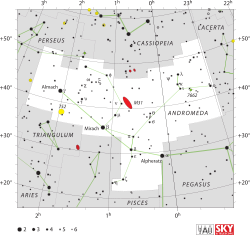Pi Andromedae
| Observation data Epoch J2000 Equinox J2000 | |
|---|---|
| Constellation | Andromeda |
| Right ascension | 00h 36m 52.85132s[1] |
| Declination | +33° 43′ 09.6363″[1] |
| Apparent magnitude (V) | 4.36[2] (4.9/5.3)[3] |
| Characteristics | |
| Spectral type | B5 V[4] (B5 V + B5 V[3]) |
| U−B color index | –0.55[2] |
| B−V color index | –0.16[2] |
| Astrometry | |
| Radial velocity (Rv) | +8.7[5] km/s |
| Proper motion (μ) | RA: 14.669(118)[1] mas/yr Dec.: −3.385(93)[1] mas/yr |
| Parallax (π) | 5.6563 ± 0.1474 mas[1] |
| Distance | 580 ± 20 ly (177 ± 5 pc) |
| Orbit[3] | |
| Period (P) | 143.6 days |
| Eccentricity (e) | 0.56 |
| Details | |
| Luminosity | 1,136[6] L☉ |
| Surface gravity (log g) | 4.10[4] cgs |
| Temperature | 15,276[4] K |
| Metallicity [Fe/H] | –0.20[4] dex |
| Rotational velocity (v sin i) | 25[7] km/s |
| Other designations | |
| Database references | |
| SIMBAD | data |

Pi Andromedae (Pi And, π Andromedae, π And) is the Bayer designation for a binary star[3] system in the northern constellation of Andromeda. With an apparent visual magnitude of 4.4,[2] it is visible to the naked eye. It is located approximately 580 light-years (180 parsecs) from Earth.[1]
The pair is classified as a blue-white B-type main sequence dwarf, with an apparent magnitude of +4.34. It is a spectroscopic binary with an orbital period of 143.6 days and an eccentricity of 0.56. [3]
The spectroscopic binary forms a triple system with BD+32 102, a magnitude 8.6 star located 35.9 arcseconds away.[3] At 55 arcseconds separation is an 11th magnitude companion that is just located on the same line of sight, but at a very different distance from us.
Naming[edit]
In Chinese, 奎宿 (Kuí Sù), meaning Legs (asterism), refers to an asterism consisting of π Andromedae, η Andromedae, 65 Piscium, ζ Andromedae, ε Andromedae, δ Andromedae, ν Andromedae, μ Andromedae, β Andromedae, σ Piscium, τ Piscium, 91 Piscium, υ Piscium, φ Piscium, χ Piscium and ψ¹ Piscium. Consequently, the Chinese name for π Andromedae itself is 奎宿六 (Kuí Sù liù, English: the Sixth Star of Legs.)[8]
References[edit]
- ^ a b c d e f Brown, A. G. A.; et al. (Gaia collaboration) (2021). "Gaia Early Data Release 3: Summary of the contents and survey properties". Astronomy & Astrophysics. 649: A1. arXiv:2012.01533. Bibcode:2021A&A...649A...1G. doi:10.1051/0004-6361/202039657. S2CID 227254300. (Erratum: doi:10.1051/0004-6361/202039657e). Gaia EDR3 record for this source at VizieR.
- ^ a b c d Johnson, H. L.; et al. (1966), "UBVRIJKL photometry of the bright stars", Communications of the Lunar and Planetary Laboratory, 4 (99): 99, Bibcode:1966CoLPL...4...99J.
- ^ a b c d e f Eggleton, P. P.; Tokovinin, A. A. (September 2008). "A catalogue of multiplicity among bright stellar systems". Monthly Notices of the Royal Astronomical Society. 389 (2): 869–879. arXiv:0806.2878. Bibcode:2008MNRAS.389..869E. doi:10.1111/j.1365-2966.2008.13596.x. S2CID 14878976.
- ^ a b c d Cenarro, A. J.; et al. (January 2007), "Medium-resolution Isaac Newton Telescope library of empirical spectra - II. The stellar atmospheric parameters", Monthly Notices of the Royal Astronomical Society, 374 (2): 664–690, arXiv:astro-ph/0611618, Bibcode:2007MNRAS.374..664C, doi:10.1111/j.1365-2966.2006.11196.x, S2CID 119428437.
- ^ Wilson, Ralph Elmer (1953), "General Catalogue of Stellar Radial Velocities", Carnegie Institute Washington D.C. Publication, Washington: Carnegie Institution of Washington, Bibcode:1953GCRV..C......0W.
- ^ Anderson, E.; Francis, Ch. (2012), "XHIP: An extended hipparcos compilation", Astronomy Letters, 38 (5): 331, arXiv:1108.4971, Bibcode:2012AstL...38..331A, doi:10.1134/S1063773712050015, S2CID 119257644.
- ^ Abt, Helmut A.; Levato, Hugo; Grosso, Monica (July 2002), "Rotational Velocities of B Stars", The Astrophysical Journal, 573 (1): 359–365, Bibcode:2002ApJ...573..359A, doi:10.1086/340590.
- ^ (in Chinese) AEEA (Activities of Exhibition and Education in Astronomy) 天文教育資訊網 2006 年 5 月 19 日

